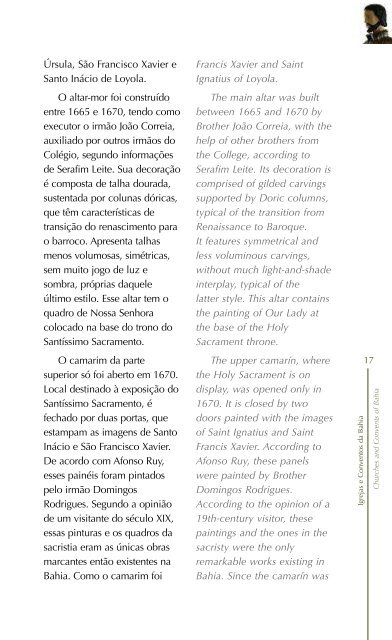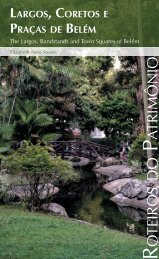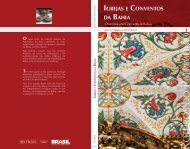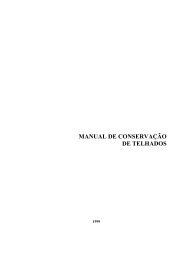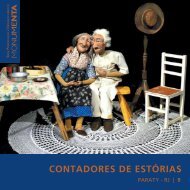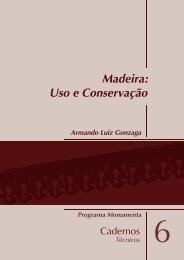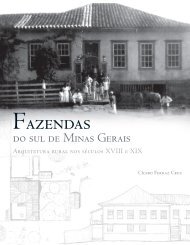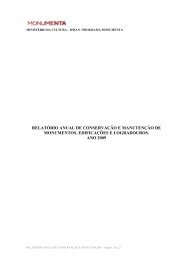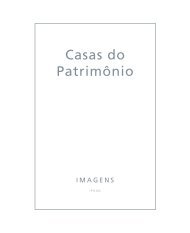Igrejas e Conventos da Bahia - Monumenta
Igrejas e Conventos da Bahia - Monumenta
Igrejas e Conventos da Bahia - Monumenta
You also want an ePaper? Increase the reach of your titles
YUMPU automatically turns print PDFs into web optimized ePapers that Google loves.
Úrsula, São Francisco Xavier e<br />
Santo Inácio de Loyola.<br />
O altar-mor foi construído<br />
entre 1665 e 1670, tendo como<br />
executor o irmão João Correia,<br />
auxiliado por outros irmãos do<br />
Colégio, segundo informações<br />
de Serafim Leite. Sua decoração<br />
é composta de talha doura<strong>da</strong>,<br />
sustenta<strong>da</strong> por colunas dóricas,<br />
que têm características de<br />
transição do renascimento para<br />
o barroco. Apresenta talhas<br />
menos volumosas, simétricas,<br />
sem muito jogo de luz e<br />
sombra, próprias <strong>da</strong>quele<br />
último estilo. Esse altar tem o<br />
quadro de Nossa Senhora<br />
colocado na base do trono do<br />
Santíssimo Sacramento.<br />
O camarim <strong>da</strong> parte<br />
superior só foi aberto em 1670.<br />
Local destinado à exposição do<br />
Santíssimo Sacramento, é<br />
fechado por duas portas, que<br />
estampam as imagens de Santo<br />
Inácio e São Francisco Xavier.<br />
De acordo com Afonso Ruy,<br />
esses painéis foram pintados<br />
pelo irmão Domingos<br />
Rodrigues. Segundo a opinião<br />
de um visitante do século XIX,<br />
essas pinturas e os quadros <strong>da</strong><br />
sacristia eram as únicas obras<br />
marcantes então existentes na<br />
<strong>Bahia</strong>. Como o camarim foi<br />
Francis Xavier and Saint<br />
Ignatius of Loyola.<br />
The main altar was built<br />
between 1665 and 1670 by<br />
Brother João Correia, with the<br />
help of other brothers from<br />
the College, according to<br />
Serafim Leite. Its decoration is<br />
comprised of gilded carvings<br />
supported by Doric columns,<br />
typical of the transition from<br />
Renaissance to Baroque.<br />
It features symmetrical and<br />
less voluminous carvings,<br />
without much light-and-shade<br />
interplay, typical of the<br />
latter style. This altar contains<br />
the painting of Our Lady at<br />
the base of the Holy<br />
Sacrament throne.<br />
The upper camarín, where<br />
the Holy Sacrament is on<br />
display, was opened only in<br />
1670. It is closed by two<br />
doors painted with the images<br />
of Saint Ignatius and Saint<br />
Francis Xavier. According to<br />
Afonso Ruy, these panels<br />
were painted by Brother<br />
Domingos Rodrigues.<br />
According to the opinion of a<br />
19th-century visitor, these<br />
paintings and the ones in the<br />
sacristy were the only<br />
remarkable works existing in<br />
<strong>Bahia</strong>. Since the camarín was<br />
<strong>Igrejas</strong> e <strong>Conventos</strong> <strong>da</strong> <strong>Bahia</strong><br />
17<br />
Churches and Convents of <strong>Bahia</strong>


